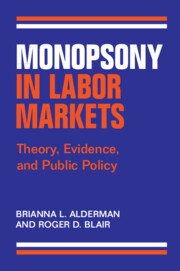Book contents
- Monopsony in Labor Markets
- Monopsony in Labor Markets
- Copyright page
- Dedication
- Contents
- Figures
- Tables
- Preface
- Acknowledgments
- 1 Monopsony in the Labor Market
- 2 The Economics of Monopsony
- 3 Empirical Evidence of Monopsony in Labor Markets
- 4 Antitrust Policy in the United States
- 5 The Intended and Unintended Victims of Monopsony
- 6 Collusion on Wages and Terms of Employment
- 7 No-Poaching Agreements
- 8 Noncompete Agreements
- 9 Unions and Collective Bargaining
- 10 Monopsony and Merger Policy
- 11 Closing Thoughts
- Index
1 - Monopsony in the Labor Market
Published online by Cambridge University Press: 08 February 2024
- Monopsony in Labor Markets
- Monopsony in Labor Markets
- Copyright page
- Dedication
- Contents
- Figures
- Tables
- Preface
- Acknowledgments
- 1 Monopsony in the Labor Market
- 2 The Economics of Monopsony
- 3 Empirical Evidence of Monopsony in Labor Markets
- 4 Antitrust Policy in the United States
- 5 The Intended and Unintended Victims of Monopsony
- 6 Collusion on Wages and Terms of Employment
- 7 No-Poaching Agreements
- 8 Noncompete Agreements
- 9 Unions and Collective Bargaining
- 10 Monopsony and Merger Policy
- 11 Closing Thoughts
- Index
Summary
Monopsony is the label that Joan Robinson attached to a market in which a single employer faces a competitively structured supply of labor. For some reason, her early theoretical analysis, along with the insights of A. C. Piguo and J. R. Hicks, did not gain much traction. Recently, however, economists and policymakers have recognized the ill effects of monopsony and have offered some actions aimed at mitigating – if not eliminating – the monopsony problem. In our view, vigorous enforcement – both public and private – of the antitrust laws can play a large role in reducing the ill effects of monopsony power in the labor market.
- Type
- Chapter
- Information
- Monopsony in Labor MarketsTheory, Evidence, and Public Policy, pp. 1 - 14Publisher: Cambridge University PressPrint publication year: 2024

